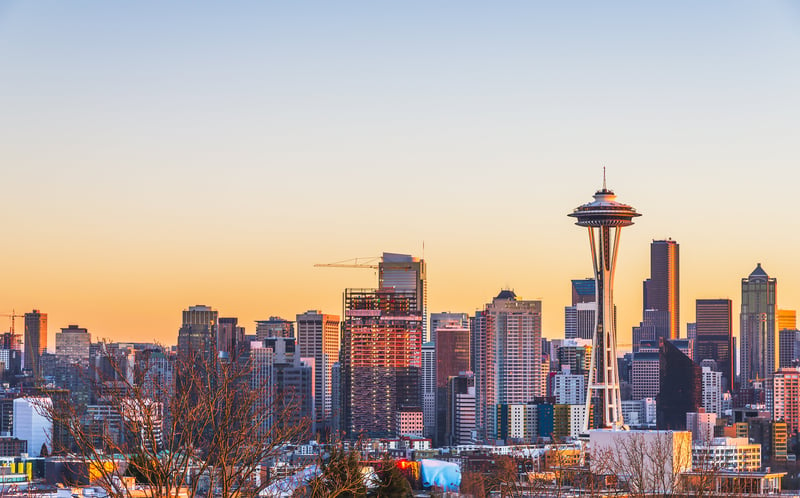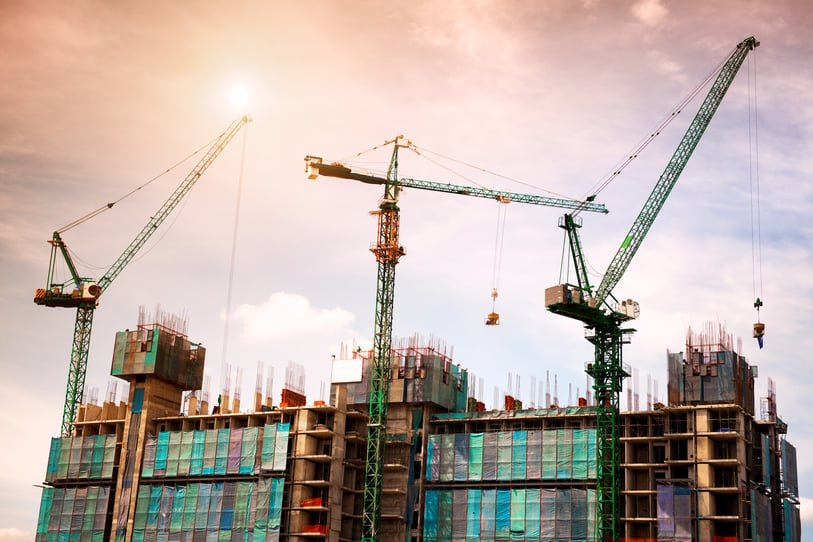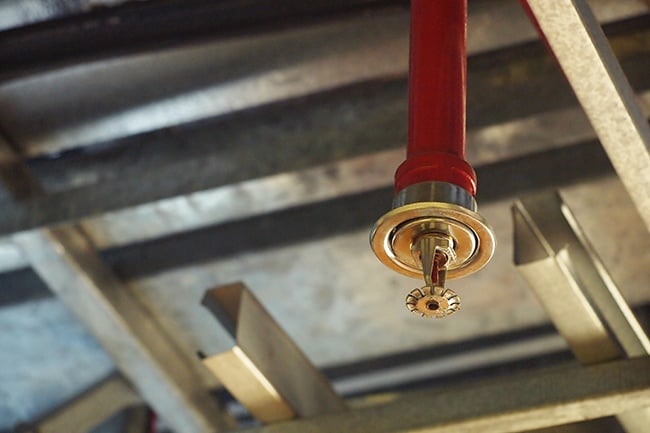Guide to Commercial Property Risk Assessment
Discover the details you need to rate and underwrite commercial property and learn how our inspections and advisory loss costs can help

Get the most value from this guide
Assessing the risk associated with a commercial property involves looking at many complex and sometimes interrelated factors. We wrote this guide to help insurance raters and underwriters learn more about some of these factors, particularly those related to our work.
We're an independent, not-for-profit organization operating in the public interest. We inspect commercial properties and produce advisory loss costs for properties in Washington state. Insurers use this data to evaluate property risk, primarily related to fire but also earthquakes and other hazards.
This guide explains key inputs to our loss costs along with important property insurance terms and concepts, including those we often get questions about. Here, we provide a summary of the information we have published on our blog. Throughout the guide, you'll find links to posts with more detail.
Note we only inspect properties and produce loss costs for properties in Washington state; if you have questions related to property inspections in other states, learn more here.
Loss costs
Though many factors go into determining a building's loss cost, the concept of a loss cost is relatively simple. It's the portion of an insurer's rate that covers losses and the costs associated with settling those losses. That includes both the amount the insurer would pay to the policyholder and expenses related to loss adjustment.
A loss cost is not a subjective assessment; it is the output of a mathematical calculation that's been approved by the Washington State Office of the Insurance Commissioner.
Check out our quick reference guide to loss costs for an introductory primer.
Finding the loss cost for a risk
The loss cost does not include costs for underwriting profit, contingencies, or other expenses such as commissions, sales, marketing, and taxes. These other factors go into what's called a loss cost multiplier, which each insurer determines for itself and files with the insurance commissioner. To determine a rate, multiply the property's loss cost by your company's loss cost multiplier.
The loss cost for many businesses can be determined without an inspection. In other words, the risk can be class rated. Large businesses or those involved in hazardous operations usually need to be specifically rated and therefore require an inspection. The ultimate determiner of whether a building can be class rated or requires an inspection is Rule 85 in the Commercial Lines Manual.
If you need a specific rating for a building in Washington state, log in to check if we've already inspected it. Here are step-by-step instructions on how to find an inspection report. If we have inspected the building, you can consult the commercial property report for the information you need. If we haven't inspected the building, the inspection is out-of-date or the occupancy has changed since the last inspection, you can order a new inspection at no additional cost. Commercial building inspections are included in your company's subscription to our services.
Our Subscribers can access loss cost reports on any building we've inspected. To learn more about what you'll see when you search for a property in the Subscriber Solutions portion of our website, click here. You'll see a screenshot of a sample report along with explanations for each piece of information in the report.
Key codes to know
Two components you'll see in our reports are CSP codes and RCP codes. We often hear questions about what these mean.
The CSP in CSP code stands for Commercial Statistical Plan. Each code contains risks grouped together based on data related to losses, occupant types, premiums, exposures, and other factors. For example, bars and taverns are CSP code 0541. A restaurant with cooking is CSP code 0542, and a restaurant with limited cooking is 0545. Loss costs are based in part on the loss statistics that go into determining a CSP code, which is one reason we include them in our reports. We created a list of some of the most common CSP codes that you can find here. For a complete list of all CSP codes, consult the Commercial Lines Manual.
An RCP code tells you the Rating, Construction, and Protection information for a building.
The rating could be 1, 2, or 4. Rating 1 is for specifically rated buildings without sprinkler system credit; 2 is for class-rated buildings and 4 is for specifically rated buildings with sprinkler system credit. Some other rating organizations use rating 3 for class-rated buildings with substandard conditions, but WSRB doesn't.
The construction portion of the RCP code tells you the construction class.
The protection component tells you the protection class (PC).
The point of the RCP code is to give underwriters and raters a quick summary of key information related to any risk they're assessing.

Commercial property inspections
When you order an inspection from us, we send a skilled commercial property analyst to visit the property in person and look for specific risk factors. We inspect many kinds of facilities, from dry cleaners to manufacturing plants to restaurants.
Some parts of the inspection process are the same for every business, but other parts depend on the nature of the business (or businesses) we're visiting. The causes of potential fire risk vary, to some degree, from business to business. A warehouse has different sources of risk than a diner, for example, and we account for that in our inspections.
On a visit to a restaurant, our inspector:
- Determined the building's construction class and earthquake classification, both factors related to the construction materials used.
- Evaluated the kitchen equipment, including the exhaust system and fire suppression system because, in restaurants, that's the main source of potential fire risk.
- Checked fire extinguishers and sprinkler systems.
- Looked at nearby buildings to include exposure information in the final report.
Get more information about what to expect from one of our visits here. We encourage you to share this link with property owners who will soon be inspected. When the owner and occupants understand who we are and what we're doing, the inspection process often goes more smoothly, and you get your results faster.
Common commercial property risk issues
We inspect each business based on its individual characteristics, but we see some of the same fire-related risk issues over and over again. These risk factors can significantly affect insurance loss costs and are important for property owners to know. Some common issues include:
- No automatic fire sprinkler system.
- Lack of approved rag cans. If not properly contained, oil-soaked rags can spontaneously catch fire hours or even days after use.
- Unprotected gas meter or piles of debris next to the building.
Learn more about the top 10 commercial building risk issues we see here. Sharing this information with property owners can help them understand their risk and reduce it.

Construction classes
During every property inspection, our analysts determine the building's construction class (CC), and you'll see the information in our commercial property reports. Knowing a building's CC can help you understand its fire risk because the CC encapsulates specific information about the materials making up the walls, siding, floor, and roof.
It's not easy to determine a building's CC by quickly looking at it. For example, a building could have metal siding but turn out to have a wood frame, making it a different CC than it appears at first glance. On the interior, obstructions sometimes prevent a complete view of construction features relevant to determining the CC.
In addition, the Commercial Lines Manual specifically defines each CC, and there are special considerations for buildings made up of multiple different classes. The easiest way to accurately determine the CC of a building in Washington state is to have us inspect it. Our skilled commercial property analysts are well-versed in the definition of each CC and in determining the correct CC for mixed construction buildings. To order an inspection, simply log in to your account and follow these steps.
An overview of each construction class
As the number associated with each CC increases, so does the fire resistance of that CC.
Frame buildings (CC 1), are common in Washington state; they're relatively inexpensive to build and tend to hold up well over time when compared to buildings of other types. However, the wood frames of these buildings make them the most combustible of the CCs. As a result, automatic fire sprinkler systems could help owners of these buildings get discounts on their insurance.
Many, but not all, joisted masonry buildings (CC 2) are made of poured-in-place or tilt-up concrete, hollow concrete block, brick, or similar materials. Some are made with a metal frame and combustible roof. Joisted masonry buildings are similar to frame buildings in that they're also relatively inexpensive to construct. However, CC 2 buildings are more durable and fire-resistant than wood buildings, and easy to maintain.
Non-combustible buildings (CC 3) are often used as warehouses and manufacturing facilities. They have structures that don't fuel a potential fire, but the steel used in them is unprotected, so it could become structurally unsound when heated. An automatic fire sprinkler system helps decrease the chances that the metal will get hot enough to be compromised.
Masonry non-combustible buildings (CC 4) are similar to joisted masonry buildings but have floors and roofs made of metal or another non-combustible material. In other words, CC 4 buildings have the wall characteristics of CC 2 buildings but the floor and roof characteristics of CC 3 buildings.
Modified fire-resistive buildings (CC 5) are more fire resistant than buildings in the previous four classes. Buildings in CC 5 are especially difficult to identify. Even professional inspectors prefer consulting construction plans before settling on this classification.
Fire-resistive buildings (CC 6) are best able to withstand fire, but they are not completely fireproof. Still, they feature floor and roof assemblies that are rated to withstand fire for at least two hours. All modern skyscrapers fall into this CC, but not all CC 6 buildings are skyscrapers.
Mixed construction buildings have a CC number based on the various types of construction present and the percentage of each. To determine which CC a mixed construction building falls into, it's best to have an inspection. Log in today to request one.

Automatic fire sprinkler systems
The presence of an automatic fire sprinkler system can make a major difference in fire-related property risk, no matter what the building is made of. Even a non-combustible building has contents that can burn potentially hot enough to affect the metal or concrete in the structure.
Modern sprinkler systems in commercial buildings are designed to detect fire, activate the sprinklers, and send an alarm to a monitoring company, which in turn alerts the fire department. While the alarm is relayed and firefighters dispatched, the sprinklers control the fire until the firefighters arrive and fully extinguish it.
Yes, sprinkler systems can cause water damage but not as much damage as a prolonged fire could cause. Without a sprinkler system, the fire will burn longer, causing more property damage. And, when firefighters arrive on the scene, their hoses will disperse a lot of water in a short time period, likely causing more water damage than the sprinklers would have.
WSRB's sprinkler system assessment
Learn more about our sprinkler grading services here.
When we inspect a building, we carefully assess any sprinkler systems installed. Many factors go into determining whether the sprinkler system will adequately protect the property from major fire damage.
One factor is how the building is currently used. Imagine a warehouse with high stacks of boxes - it needs a different sprinkler system than an office building with desks and meeting rooms. But what if the office building has server rooms, kitchens, or storage areas full of combustible materials? Those can all affect the required capabilities of the sprinkler system, so we look at those too.
Over time, building usage may change, so we suggest having a new inspection conducted whenever occupancy changes. If you're a WSRB Subscriber, there's no limit to the number of inspections you can order. Simply log in and request one. Find instructions here.
Maintenance is another factor affecting sprinkler system effectiveness. Indeed, lack of maintenance is one of the main reasons a fire sprinkler fails. Other reasons include corrosion, other internal pipe problems or simply being turned off.
We check building usage, and system maintenance, and use specific criteria to ensure consistency across all our fire sprinkler system inspections. Sometimes, we grant a system only partial rate credit, and that might not be what the agent, rater, underwriter, or property owner expected.
There are many reasons a system might not earn full rate credit. Common reasons include:
- No "as-built" plans are available for our inspector to review.
- Maintenance has not been performed on schedule.
- The sprinkler system is not designed for the current occupancy.
Learn about more reasons why a building with a sprinkler system might not be coded and rated as fully sprinklered. Not all roadblocks to sprinkler credit are permanent, though. Because sprinkler systems have proven so valuable and effective over the years, we can now grant at least some credit to all eligible systems. Learn more here about what eligible means and how you can help a building owner get credit for an automatic fire sprinkler system.

Policy rating for commercial property
The ultimate purpose of a loss cost and commercial property inspection (if one is necessary) is to develop a premium for a commercial property. Remember, the loss cost includes just the part of an insurer's rate that covers losses and the costs associated with settling those losses. It doesn't include other costs, expenses, or taxes. That's all part of the loss cost multiplier, which you multiply by the loss cost to determine a rate.
To develop a premium, a rater or underwriter needs to consider seven factors:
- Coverage form (building, contents, business income, etc.)
- Cause of loss form (Basic Form, Broad Form, Special Form, Earthquake Form)
- Construction of the building
- Occupancy of the building
- Location of the property
- Amount of insurance being written
- Applicable coinsurance requirement
Some of this information, such as the construction and occupancy of the building, you'll get from one of our commercial property reports. The rest will come from various sources, and some depends on the insured's preferences. While one customer might want comprehensive coverage for many causes of loss, another may prefer minimal coverage for just the most basic causes.
For more details about each of the seven factors listed above, check out our blog post on the subject. Some of these factors, such as the Basic Form, Broad Form, Special Form, and coinsurance are complex, so we've created in-depth blog posts covering each. We also have a post on green construction upgrades and how they can affect property insurance rating.
Still have questions?
We hope this guide and the linked articles answered your questions about commercial property risk assessment, property inspections, and loss costs. If not, please contact our Customer Service team.








